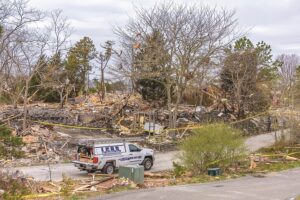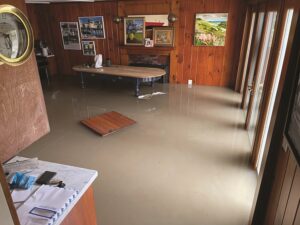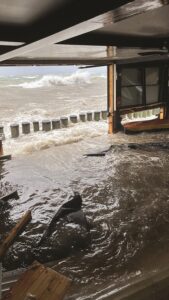TRURO — Four months ago, a massive explosion razed the home of Todd and Miriam Henning. Detritus still hangs from scorched trees at 8 Harding’s Way, but other than that, there are few remaining signs of the propane-tank explosion that shook houses as far away as Brewster.

But for the Henning family, the disaster isn’t over. They are still awaiting payment for their insurance claim on the 3,200-square-foot house after months of contesting appraisals issued by the Mass. Property Insurance Underwriting Association (MPIUA).
MPIUA, also known as the FAIR Plan, provides access to insurance for homeowners who are having trouble insuring their properties because they are in high-risk locations. Initially intended to cover properties in areas with high crime rates, it is now commonly used in coastal areas. According to the Mass. insurance commissioner’s 2021 annual report, MPIUA wrote 33 percent of home insurance policies on the Cape and Islands.
The Hennings’ initial damage appraisal issued by Friedline and Carter, a third-party adjusting firm contracted by MPIUA, “wasn’t at all accurate to the structure we lost,” their son, Ari Henning, said. Friedline and Carter estimated a cost of $325 per square foot to rebuild; Ari said that local builders gave quotes of $400 to $500 per square feet.
That difference would leave the family on the hook for $240,000 to $560,000 in construction costs, he said.
When Ari contested the appraisal, he said, the adjuster told him, “That’s the algorithm we use; there’s nothing we can do about it.”
But that algorithm estimated the cash value of replacement “within the penny of what would have triggered them to pay us outright,” Ari said. The Hennings’ insurance policy stipulated that, if the adjuster’s estimate came out above the policy limit, the company would automatically pay that amount. If the estimate were below the limit, the company would reimburse the family only after they paid to have the site cleared and a foundation poured, and “that’s money we don’t have,” Ari said.

Eventually, MPIUA acquiesced to the family’s objection, Ari said, and raised the estimate to the policy limit.
Tim Ball, a public adjuster for Ball & Boyd in Hyannis, said that an estimate after depreciation “is very subjective,” but that a “policy limit is a number that stands alone and should never have an impact on the calculation of the damage.”
Ball also said that the Outer Cape and Islands “are different animals” when it comes to material costs. “We have trouble sometimes, because insurers don’t believe, nor do they want to believe, what things cost in those areas,” Ball said.
“I have learned that if you’re not in a position where you have a ton of money saved up, you’re going to be in trouble,” Ari said.
After the Flood
It is almost eight months now since the coastal flooding of Dec. 23, when a river of seawater invaded homes and businesses in Provincetown’s East End. But Quinn Taylor, whose ground-floor unit in the historic Captain Dyer house on Commercial Street filled with three feet of water, is still waiting for money to pay the contractors who had to gut his home to the studs.
Taylor is enrolled in the National Flood Insurance Program (NFIP), a lender for federally backed mortgages in high-risk areas. According to the NFIP website, there were 906 policies in force in Provincetown in 2022, and 1,471 across the four Outer Cape towns.

Taylor said he has received only half of what the adjusting firm, Johns Eastern, promised him through the NFIP. He said he and his upstairs neighbors have been “begging for money that we were told we are getting. It’s a daily phone call asking when it’s coming, and all we get are crickets.”
Richard Lennox, president of Disaster Specialists, Taylor’s contractor, said the delay is so extreme that he may contact the state insurance commissioner to help broker the payment. “I have never seen anything like this,” Lennox said. “You call the people that are in charge, and they don’t respond. It’s horrendous.”
Because the NFIP is a federal program, many times the adjusters “come from God knows where,” Lennox added. He said the last time he spoke to Taylor’s adjuster, he was working on a hailstorm in Texas.
As with the Hennings, the estimates that Taylor received “are not lining up with what it actually costs to do the work out here,” Lennox added.
Taylor has lived at four different friends’ homes since the flood pushed him and his neighbors out of their house, he said. One of his neighbors has been living in Eastham, and the other in New Hampshire.
“We’ve become this squeaky wheel, hounding the adjuster to get our money released,” Taylor said. “It’s debilitating. It’s also degrading.”
Paul Fanizzi, whose restaurant was both inundated with seawater and smashed by waves during last December’s storm, has experience with floods and the NFIP. His dining room flooded in 2002, and the basement flooded in 2018.
During the December 2022 storm, three feet of salt water rushed into the restaurant’s dining room, which had been outfitted with breakaway panels so the structure itself would not be damaged.
Fanizzi said he pays $20,000 per year for the NFIP. Insurance paid him $280,000 for the December flood, but Fanizzi estimated that repairs cost an additional $200,000. He had to replace the restaurant’s deck, seawall, and pylons, all of which insurance refused to cover, he said. He is still working on replacing the deck and seawall.
Insurance also wouldn’t cover anything above the three-foot waterline. “The water was splashing the ceiling, damaging speakers and artwork,” Fanizzi said. “They wouldn’t cover any of it because it was over the waterline, even though it was all damaged by the ocean.”
Fanizzi also said he had trouble contacting the adjuster appraising the contents of the restaurant. “He kept saying his email was hacked so he couldn’t get a hold of me, and he wouldn’t answer my phone calls.”
In March, three months after the storm, he heard back from the adjuster. “He said if I didn’t sign the form by midnight, I wouldn’t get any money at all,” Fanizzi said.
Dealing with insurance has been “more than a full-time job,” Fanizzi said. “It didn’t feel like they were on my side this time.”



